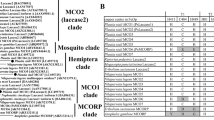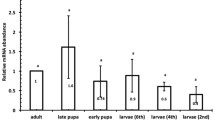Abstract
Background
T-type calcium channels, characterized as low-voltage activated (LVA) calcium channels, play crucial physiological roles across a wide range of tissues, including both the neuronal and nonneuronal systems. Using in situ hybridization and RNA interference (RNAi) techniques in vitro, we previously identified the tissue distribution and physiological function of the T-type calcium channel α1 subunit (DdCα1G) in the plant-parasitic nematode Ditylenchus destructor.
Methods and results
To further characterize the functional role of DdCα1G, we employed a combination of immunohistochemistry and fungus-mediated RNAi and found that DdCα1G was clearly distributed in stylet-related tissue, oesophageal gland-related tissue, secretory-excretory duct-related tissue and male spicule-related tissue. Silencing DdCα1G led to impairments in the locomotion, feeding, reproductive ability and protein secretion of nematodes. To confirm the defects in behavior, we used phalloidin staining to examine muscle changes in DdCα1G-RNAi nematodes. Our observations demonstrated that defective behaviors are associated with related muscular atrophy.
Conclusion
Our findings provide a deeper understanding of the physiological functions of T-type calcium channels in plant-parasitic nematodes. The T-type calcium channel can be considered a promising target for sustainable nematode management practices.









Similar content being viewed by others
Explore related subjects
Discover the latest articles and news from researchers in related subjects, suggested using machine learning.Data availability
The data of the present study are available from the corresponding author upon reasonable request.
References
Bootman MD, Collins TJ, Peppiatt CM, Prothero LS, MacKenzie L, De Smet P, Travers M, Tovey SC, Seo JT, Berridge MJ, Ciccolini F, Lipp P (2001) Calcium signalling–an overview. Semin Cell Dev Biol 12:3–10. https://doi.org/10.1006/scdb.2000.0211
Abdulla FA, Smith PA (1997) Nociceptin inhibits T-type Ca2+ channel current in rat sensory neurons by a G-protein-independent mechanism. J Neuroscience: Official J Soc Neurosci 17:8721–8728. https://doi.org/10.1523/jneurosci.17-22-08721.1997
Artalejo CR, Adams ME, Fox AP (1994) Three types of Ca2+ channel trigger secretion with different efficacies in chromaffin cells. Nature 367:72–76. https://doi.org/10.1038/367072a0
Neely A, Hidalgo P (2014) Structure-function of proteins interacting with the α1 pore-forming subunit of high-voltage-activated calcium channels. Front Physiol 5:209. https://doi.org/10.3389/fphys.2014.00209
Mangoni ME, Couette B, Bourinet E, Platzer J, Reimer D, Striessnig J, Nargeot J (2003) Functional role of L-type Cav1.3 Ca2+ channels in cardiac pacemaker activity. Proc Natl Acad Sci USA 100:5543–5548. https://doi.org/10.1073/pnas.0935295100
Perez-Reyes E (2003) Molecular physiology of low-voltage-activated T-type calcium channels. Physiol Rev 83:117–161. https://doi.org/10.1152/physrev.00018.2002
Weiss N, Zamponi GW (2024) The T-type calcium channelosome, Pflugers Archiv: European journal of physiology, 476. 163–177. https://doi.org/10.1007/s00424-023-02891-z
Klugbauer N, Marais E, Lacinová L, Hofmann F (1999) A T-type calcium channel from mouse brain. Pflug Arch: Eur J Physiol 437:710–715. https://doi.org/10.1007/s004240050836
Steger KA, Shtonda BB, Thacker C, Snutch TP, Avery L (2005) The C. Elegans T-type calcium channel CCA-1 boosts neuromuscular transmission. J Exp Biol 208:2191–2203. https://doi.org/10.1242/jeb.01616
Shtonda B, Avery L (2005) CCA-1, EGL-19 and EXP-2 currents shape action potentials in the Caenorhabditis elegans pharynx. J Exp Biol 208:2177–2190. https://doi.org/10.1242/jeb.01615
Zang KE, Ho E, Ringstad N (2017) Inhibitory peptidergic modulation of C. Elegans serotonin neurons is gated by T-type calcium channels, eLife. 6:e22771. https://doi.org/10.7554/eLife.22771
Ye S, Zeng R, Zhou J, An M, Ding Z (2020) Molecular characterization of Ditylenchus destructor voltage-gated calcium channel α1 subunits and analysis of the effect of their knockdown on nematode activity. Biochimie 171–172. https://doi.org/10.1016/j.biochi.2020.02.010
Wang X, Huang S, Zheng C, Ge W, Wu C, Tse YC (2020) RSU-1 maintains Integrity of Caenorhabditis elegans Vulval muscles by regulating α-Actinin, G3 (Bethesda, Md). 10:2507–2517. https://doi.org/10.1534/g3.120.401185
Gieseler K, Qadota H, Benian GM (2017) Development, structure, and maintenance of C. Elegans body wall muscle. WormBook: Online Rev C Elegans Biology 2017:1–59. https://doi.org/10.1895/wormbook.1.81.2
Ryss A, Petrov AA (2021) Muscles of the male and female copulatory organs of Bursaphelenchus mucronatus and Chiloplacus sp. (Nematoda: Rhabditida), Journal of nematology, 53 e2021-2107, https://doi.org/10.21307/jofnem-2021-107
Pollard T.D., Cooper J.A. (2009) Actin, a central player in cell shape and movement. Sci (New York N Y) 326:1208–1212. https://doi.org/10.1126/science.1175862
Rotty JD, Bear JE (2014) Competition and collaboration between different actin assembly pathways allows for homeostatic control of the actin cytoskeleton. Bioarchitecture 5:27–34. https://doi.org/10.1080/19490992.2015.1090670
Scipion CPM, Ghoshdastider U, Ferrer FJ, Yuen TY, Wongsantichon J, Robinson RC (2018) Structural evidence for the roles of divalent cations in actin polymerization and activation of ATP hydrolysis. Proc Natl Acad Sci USA 115:10345–10350. https://doi.org/10.1073/pnas.1806394115
Shaw JE, Koleske AJ (2021) Functional interactions of ion channels with the actin cytoskeleton: does coupling to dynamic actin regulate NMDA receptors? J Physiol 599:431–441. https://doi.org/10.1113/jp278702
Gheysen G, Vanholme B (2007) RNAi from plants to nematodes. Trends Biotechnol 25:89–92. https://doi.org/10.1016/j.tibtech.2007.01.007
Lilley CJ, Davies LJ, Urwin PE (2012) RNA interference in plant parasitic nematodes: a summary of the current status. Parasitology 139:630–640. https://doi.org/10.1017/s0031182011002071
Ding S, Wang D, Xu C, Yang S, Cheng X, Peng X, Chen C, Xie H (2021) A new fungus-mediated RNAi method established and used to study the fatty acid and retinol binding protein function of the plant-parasitic nematode Aphelenchoides Besseyi. RNA Biol 18:1424–1433. https://doi.org/10.1080/15476286.2020.1852779
Ishibashi N, Takayama S, Kondo E (2005) Propagation and feeding behavior of the mycetophagous nematode, Aphelenchus avenue, on four species of soil fungi. Japanese J Nematology 35:13–19. https://doi.org/10.3725/JJN1993.35.1_13
Lim FH, Rasid OA, Idris AS, As’wad AWM, Vadamalai G, Parveez GKA, Wong MY (2021) Correction to: enhanced polyethylene glycol (PEG)-mediated protoplast transformation system for the phytopathogenic fungus, Ganoderma boninense, Folia Microbiologica. 66:877. https://doi.org/10.1007/s12223-021-00888-8
Lv W, Wang C, Yang N, Que Y, Talbot NJ, Wang Z (2017) Genome-wide functional analysis reveals that autophagy is necessary for growth, sporulation, deoxynivalenol production and virulence in Fusarium Graminearum. Sci Rep 7:11062. https://doi.org/10.1038/s41598-017-11640-z
Wang M, Wang D, Zhang X, Wang X, Liu W, Hou X, Huang X, Xie B, Cheng X (2016) Double-stranded RNA-mediated interference of dumpy genes in Bursaphelenchus xylophilus by feeding on filamentous fungal transformants. Int J Parasitol 46:351–360. https://doi.org/10.1016/j.ijpara.2016.01.008
Lim F-H, Rasid OA, Idris AS, As’wad AWM, Vadamalai G, Parveez GKA, Wong M-Y (2021) Enhanced polyethylene glycol (PEG)–mediated protoplast transformation system for the phytopathogenic fungus, Ganoderma boninense, Folia Microbiologica. 66:677–688. https://doi.org/10.1007/s12223-021-00852-6
WHITEHEAD AG, HEMMING JR (1965) A comparison of some quantitative methods of extracting small vermiform nematodes from soil. Ann Appl Biol 55:25–38. https://doi.org/10.1111/j.1744-7348.1965.tb07864.x
Schaad NW, Walker JT (1975) The use of density-gradient centrifugation for the purification of Eggs of Meloidogyne spp. J Nematology 7:203–204
Gauberg J, Abdallah S, Elkhatib W, Harracksingh AN, Piekut T, Stanley EF, Senatore A (2020) Conserved biophysical features of the CaV2 presynaptic Ca2+ channel homologue from the early-diverging animal Trichoplax adhaerens. J Biol Chem 295:18553–18578. https://doi.org/10.1074/jbc.RA120.015725
Hamada W, Reignault P, Bompeix G, Boccara M (1994) Transformation of Botrytis cinerea with the hygromycin B resistance gene, hph, current genetics. 26:251–255. https://doi.org/10.1007/bf00309556
Cenis JL (1992) Rapid extraction of fungal DNA for PCR amplification. Nucleic Acids Res 20:2380–2380. https://doi.org/10.1093/nar/20.9.2380
Livak KJ, Schmittgen TD (2001) Analysis of relative gene expression data using real-time quantitative PCR and the 2–∆∆CT method. Methods 25:402–408. https://doi.org/10.1006/meth.2001.1262
Schroeder NE, Macguidwin AE (2007) Incorporation of a fluorescent compound by live Heterodera glycines. J Nematology 39:43–49
An M, Chen X, Yang Z, Zhou J, Ye S, Ding Z (2022) Co-silencing of the Voltage-gated Calcium Channel β subunit and high-voltage activated α(1) subunit by dsRNA soaking resulted in enhanced defects in Locomotion, Stylet Thrusting, Chemotaxis, protein secretion, and Reproduction in Ditylenchus destructor. Int J Mol Sci 23. https://doi.org/10.3390/ijms23020784
Chen X, An M, Ye S, Yang Z, Ding Z (2022) The α(2)δ Calcium Channel Subunit Accessorily and independently affects the Biological function of Ditylenchus destructor. Int J Mol Sci 23. https://doi.org/10.3390/ijms232112999
Ono S, Imaging of Actin Cytoskeleton in the Nematode Caenorhabditis elegans, Methods in molecular biology (, Clifton NJ (2022) 2364 149–158, https://doi.org/10.1007/978-1-0716-1661-1_7
Duncan DB (1955) Multiple range and multiple F tests. Biometrics 11:1–42. https://doi.org/10.2307/3001478
E. BY, Ultrastructure of the stomatal region of the juvenile stage of the soybean cyst nematode, Heterodera glycines. Proc Helminthol Soc Wash, 50 (1983) 43–61
Decraemer W, Hunt DJ (2006) Structure and classification, Plant Nematology, 1. 3–32. https://doi.org/10.1079/9781780641515.000
Thapa S, Patel JA, Reuter-Carlson U, Schroeder NE (2017) Embryogenesis in the parasitic nematode Heterodera glycines is independent of host-derived hatching stimulation. BMC Dev Biol 17:2. https://doi.org/10.1186/s12861-016-0144-7
Anderson MP, Mochizuki T, Xie J, Fischler W, Manger JP, Talley EM, Scammell TE, Tonegawa S (2005) Thalamic Cav3.1 T-type Ca2+ channel plays a crucial role in stabilizing sleep. Proc Natl Acad Sci USA 102:1743–1748. https://doi.org/10.1073/pnas.0409644102
Giordanetto F, Knerr L, Wållberg A (2011) T-type calcium channels inhibitors: a patent review, Expert opinion on therapeutic patents. 21:85–101. https://doi.org/10.1517/13543776.2011.536532
Ono S, Ono K (2020) Two Caenorhabditis elegans calponin-related proteins have overlapping functions that maintain cytoskeletal integrity and are essential for reproduction. J Biol Chem 295:12014–12027. https://doi.org/10.1074/jbc.RA120.014133
Simms BA, Zamponi GW (2014) Neuronal voltage-gated calcium channels: structure, function, and dysfunction. Neuron 82:24–45. https://doi.org/10.1016/j.neuron.2014.03.016
Oertner TG, Matus A (2005) Calcium regulation of actin dynamics in dendritic spines. Cell Calcium 37:477–482. https://doi.org/10.1016/j.ceca.2005.01.016
Schell MJ, Irvine RF (2006) Calcium-triggered exit of F-actin and IP3 3-kinase A from dendritic spines is rapid and reversible. Eur J Neurosci 24:2491–2503. https://doi.org/10.1111/j.1460-9568.2006.05125.x
Wang Q, Chen M, Schafer NP, Bueno C, Song SS, Hudmon A, Wolynes PG, Waxham MN, Cheung MS (2019) Assemblies of calcium/calmodulin-dependent kinase II with actin and their dynamic regulation by calmodulin in dendritic spines. Proc Natl Acad Sci USA 116:18937–18942. https://doi.org/10.1073/pnas.1911452116
Fischer M, Kaech S, Knutti D, Matus A (1998) Rapid actin-based plasticity in dendritic spines. Neuron 20:847–854. https://doi.org/10.1016/s0896-6273(00)80467-5
Zheng JQ (2000) Turning of nerve growth cones induced by localized increases in intracellular calcium ions. Nature 403:89–93. https://doi.org/10.1038/47501
Acknowledgements
This work was supported by the National Natural Science Foundation of China (Grant No. 31872038), Natural Science Foundation of Hunan Province (Grant No.2022JJ30302), the National Key R&D Program of China (No.2023YFD1400013).
Funding
This work was supported by the National Natural Science Foundation of China (Grant No. 31872038), Natural Science Foundation of Hunan Province (Grant No.2022JJ30302), the National Key R&D Program of China (No.2023YFD1400013).
Author information
Authors and Affiliations
Contributions
Shan Ye, Zhong Ding, Zhuhong Yang and Deliang Peng designed the research. Jiahao Yang, Siyu Zhou and Ziqi Yang performed the experiments. Xuqi Shi and Haoran Liu performed the data analysis. Jiahao Yang, Zhong Ding and Shan Ye wrote the manuscript. All authors have read and agreed to the published version of the manuscript.
Corresponding authors
Ethics declarations
Ethical approval
The study did not involve human participants and/or animals.
Consent for publication
All authors give their consent to publish.
Competing interests
The authors declare no competing interests.
Additional information
Publisher’s Note
Springer Nature remains neutral with regard to jurisdictional claims in published maps and institutional affiliations.
Electronic supplementary material
Below is the link to the electronic supplementary material.
Rights and permissions
Springer Nature or its licensor (e.g. a society or other partner) holds exclusive rights to this article under a publishing agreement with the author(s) or other rightsholder(s); author self-archiving of the accepted manuscript version of this article is solely governed by the terms of such publishing agreement and applicable law.
About this article
Cite this article
Yang, J., Zhou, S., Yang, Z. et al. Silencing of the T-type voltage-gated calcium channel α1 subunit by fungus-mediated RNAi altered the structure of F-actin and caused defective behaviors in Ditylenchus destructor. Mol Biol Rep 51, 673 (2024). https://doi.org/10.1007/s11033-024-09626-y
Received:
Accepted:
Published:
DOI: https://doi.org/10.1007/s11033-024-09626-y




